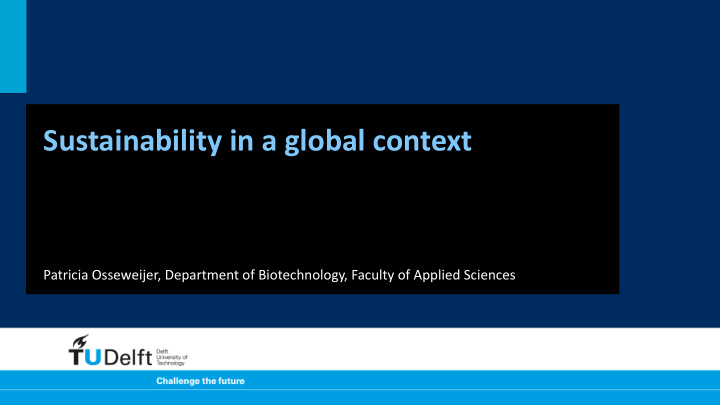



Sustainability in a global context Patricia Osseweijer, Department of Biotechnology, Faculty of Applied Sciences
Burning to mechanical harvesting of sugar cane • Safer conditions for field workers – but less jobs • Higher trained field workers – with higher income • Availability of biomass for 2 nd generation (versus 50% burned) • Higher income for farmers • Less environmental impact
Social challenge of transition to biobased production • Biobased production can help reduce climate change… Requires support and investment • Policies can help to facilitate deployment Policies are influenced by major debates of opponents and proponents of new technology
Newspaper headlines 5 January 2013, New York Times As Biofuel Demand Grows, So Do Guatemala’s Hunger Pangs The Irish Times, Saturday 30 January 2010 1 August 2013, The Guardian UK calls for 'good' biofuel plants Producers of biofuels want changes to carbon tax Government to offer £25m prize for most viable demonstration of making liquid fuel from non-food 15 April 2013, BBC News plants Biofuels: 'Irrational' and 'worse than fossil fuels‘ The Guardian, Monday 15 February 2010 The UK's "irrational" use of biofuels will cost EU biofuels significantly harming food motorists around £460 million over the next 12 months, a think tank says production in developing countries The Guardian, Thursday 18 February 2010 The Guardian , Wednesday 10 February 2010 Scrap biofuels targets and focus on A surreal argument for biofuels improved public transport
Perceptions: Biofuels causing hunger?
Location and number of undernourished population Total world population (2013): 7,2 Billion Source: FAO, 2013
Dimensions of Food Security (FAO, 2006) Availability: quantities of food of appropriate quality Access by individuals to adequate resources (entitlements) for acquiring appropriate foods for a nutritious diet Utilisation of food through adequate diet, clean water, sanitation and health care to reach a state of nutritional well-being where all physiological needs are met Stability: To be food secure, a population, household or individual must have access to adequate food at all times. They should not risk losing access to food as a consequence of sudden shocks or cyclical events
Land availability Land availability for rain-fed agriculture: 4.5 B ha very suitable/suitable • Expected need for growing food and feed demands: 130-219 Mha • Available, excluding land already in use for agriculture (1,3 Bha), forests and protected land (1,8 Bha) : 1,4 Bha, of which 955 Mha pasture land • Additional land is strongly concentrated in Latin America and Sub- Sahara Africa , and used predominately for animal grazing. Developed countries also have land available but agricultural area is expected to remain stable • In addition, 600 Mha degraded non-arable land can be used for dedicated bioenergy crops, improving soil quality & productivity At global level, land is not a constraint but availability is concentrated in two main regions Source: FAO, 2012
Share of Traditional Biomass in Residential Consumption Source: IEA, World Energy Outlook 2.5 billion people depend on traditional biomass for cooking
Alleviation of food security by bioenergy? Adapted by Lee Lynd from: Thurow, R. Kilman, S., 2009
Causal relations? Source picture 1: Johnson, Food prices in relation to fertiliser, fossil fuel, other consumables, October 2014 Source picture 2: Hsiang et al. Relation food prices and civil conflict, Nature 2011
Indirect contributions of modern bioenergy to food security 1. Increasing 2. Increasing acces to availability food of sufficient quality Availability Access Utilisation Producer Producer Food basket prices prices Food Household production Nutrient Income From land, consumption Food trade labour & capital Stability 3. Improving 4. improving functioning of markets investment climate Source: Shutes et al. 2013
Genetic modification possible benefits • improved crops for yield or management • improved microorganisms to reduce by-products and water use Source: Wilhelm Klümper, A Meta-Analysis of the Impacts of Genetically Modified Crops, November 2009
Issues in Genetic Modification • Biosafety – especially of GM food crops • Monocultures – effects on biodiversity • Power of multinationals – just distributions of harms and benefits • Biosecurity – use of GMO’s for warfare • Playing God – relates to what is life and its inherent value
Resulting in opposition
Sustainability
Opinion forming & decision making Moral principles People People Bearable Equitable Sustainable Planet Planet Profit Profit Viable Relevant facts Intuitions
Conclusion • Technology for biobased production provides many opportunities to improve economic, environmental and social dimensions • It requires well integrated designs which build on economic, environmental and social evaluation • With such designs we can work on better futures!
Further reading Literatuur en reports lijst nog toevoegen
Thank you for joining in this unit!
Recommend
More recommend